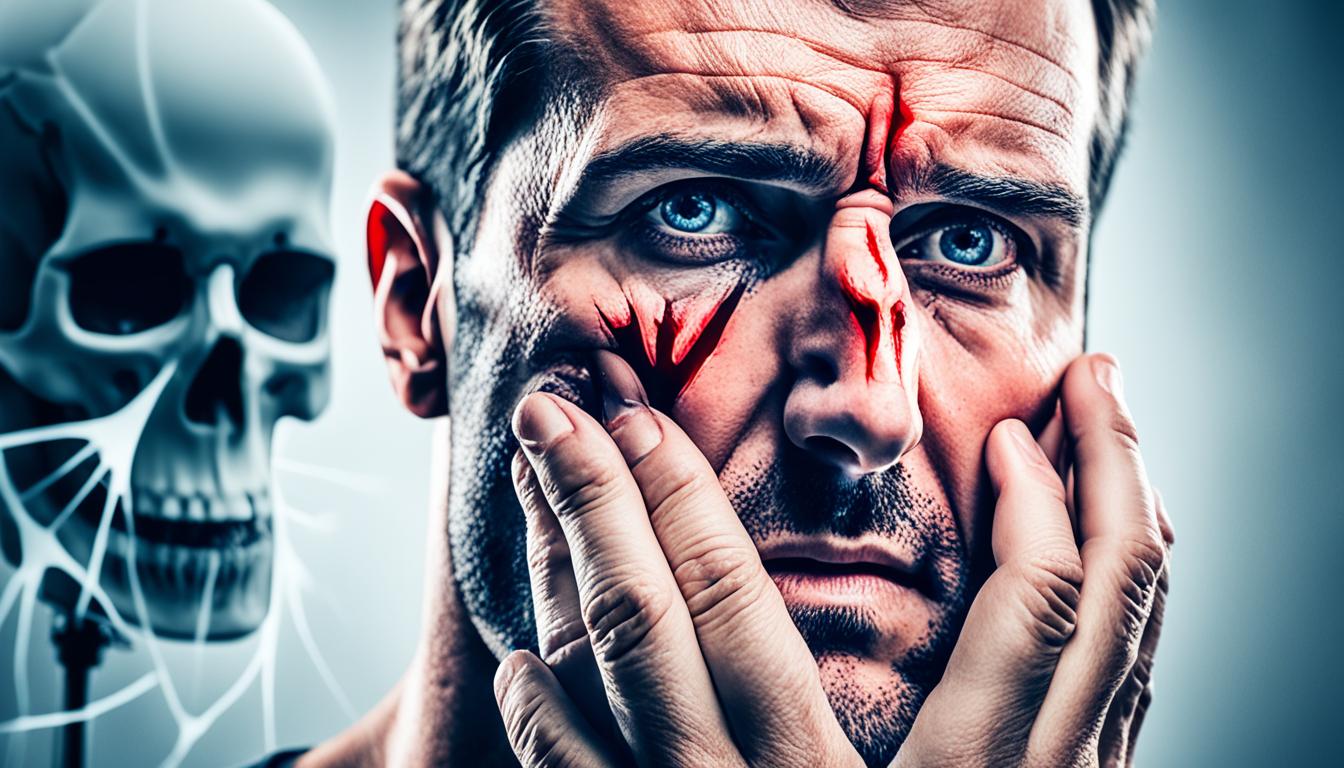Tic douloureux, or trigeminal neuralgia, is a long-term illness causing severe face pain. Individuals feel sharp, stabbing pain in their face. It can be steady or come sharply, lasting from a second to several minutes.
This pain generally affects one face side, sometimes both. Factors like face touching, eating, and talking can trigger it. Even a light breeze can cause intense discomfort.
Over time, this condition worsens, making pain attacks more common and severe. This leads to anxiety and avoiding social activities. Diagnosis is often through observed symptoms and a medical exam. Doctors might also use MRI to check for other issues.
There are several treatment paths available. These options include medicines to lessen pain and surgeries. For instance, one surgical method is microvascular decompression. Advanced methods like stem cell therapy also show positive outcomes, offering new hope.
Key Takeaways:
- Tic douloureux stands for trigeminal neuralgia, a condition known for its severe face pain.
- The pain is described as sharp and comes in intense episodes, sometimes affecting daily activities.
- As time passes, the pain episodes grow more frequent and intense, affecting life quality.
- Diagnosis usually involves examining symptoms and sometimes doing imaging tests to confirm trigeminal neuralgia.
- For management, treatment includes medications, surgery options, and the promising stem cell therapy.
Causes and Diagnosis of Tic Douloureux
Tic douloureux is also known as trigeminal neuralgia. It can come from nerve compression, multiple sclerosis, or tumors near the brainstem. The trigeminal nerve, when pressed by a blood vessel or a tumor, causes intense facial pain.
Damaging the trigeminal nerve itself can occur from strokes or facial injuries. This damage affects the protective myelin sheath. It causes the nerve to send wrong pain messages, leading to intense pain episodes.
Some cases show that tic douloureux might have a genetic link. If the condition runs in your family, it might mean you are more likely to get it. Knowing your family’s health history could help predict your risk.
Tic douloureux is diagnosed by its sudden and severe pain episodes. These episodes happen on one side of the face and are set off by simple things like eating. Doctors closely watch for these symptoms to make a diagnosis.
Doctors use certain tests to confirm trigeminal neuralgia over other similar conditions. They consider the distinct pain attacks, and they rule out other illnesses. These steps help with an accurate diagnosis.
Imaging tests such as MRI can show what’s happening in your head. They help doctors see if there’s any pressure on the nerve or if there are tumors. This helps to pinpoint the cause of the symptoms.
Causes of Tic Douloureux:
| Cause | Description |
|---|---|
| Nerve Compression | Compression of the trigeminal nerve by an artery, vein, or brain tumor |
| Trigeminal Nerve Damage | Damage to the myelin sheath that protects the trigeminal nerve, often due to multiple sclerosis, stroke, or facial trauma |
| Cerebellopontine Angle Tumors | Tumors located in the cerebellopontine angle area of the brain, which can exert pressure on the trigeminal nerve |
| Genetic Predisposition | Evidence suggests that trigeminal neuralgia may run in families, indicating a potential genetic component |
Understanding the causes and diagnosis of tic douloureux helps doctors. They can find the best treatment. Early diagnosis is key to lessen pain and improve life quality.
Advances in Stem Cell Therapy for Tic Douloureux
Stem cell therapy is becoming a hopeful treatment for tic douloureux, or trigeminal neuralgia. Stem cells can become many different cell types in the body. They offer a new way to heal nerve damage.
This method gives hope to people with severe face pain. Trials are testing how safe and effective stem cell therapy is for this condition. So far, the results are promising.
Stem cell therapy doesn’t need surgery, making it less invasive. It could provide a long-term way to manage pain. As we learn more, this therapy might be a common choice for people with tic douloureux. This could mean a better future for those with the condition.

